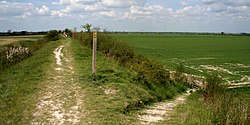Reach
| Reach | |
| Cambridgeshire | |
|---|---|
 Towards Reach from Devil's Dyke | |
| Location | |
| Grid reference: | TL570662 |
| Location: | 52°16’12"N, 0°18’0"E |
| Data | |
| Population: | 358 (2011) |
| Post town: | Cambridge |
| Postcode: | CB25 |
| Dialling code: | 01638 |
| Local Government | |
| Council: | East Cambridgeshire |
| Parliamentary constituency: |
South East Cambridgeshire |
Reach is a small village on the edge of the fenland in Cambridgeshire. It sits at the northern end of Devil's Dyke, about a mile and a half west of Burwell.
The dyke guarded the gap between the hills and the fens, and it ends at Reach as here the Great Fen begins, now drained into rich agricultural land.
History
Reach was an important economic centre in early Anglo-Saxon and Viking times. Goods were loaded at its common hythe for transport into the fen waterway system from at least 1100. Reach was a significant producer of clunch, a chalky stone; a new wood has been planted on the old clunch pits, where chalky cliffs are visible from early quarrying. Reach's use as a port continued until about 200 years ago.
When the Anglo-Saxons built Devil's Dyke around the 6th century, the northern end of the dyke split the village in two (East Reach and West Reach) until part of it was refilled to create the current Fair Green in the 18th century. East Reach has since vanished, filled in by arable land.
In the Middle Ages, Reach was a hamlet sitting on the border of the parishes of Burwell and Swaffham Prior. Today it is part of the parish of 'Burwell with Reach'. In 1961 Reach became a separate civil parish (which covers an area of 1,044 acres).
Reach Lode, a dug channel, possibly Roman in origin, remains navigable. The village church, originally Holy Trinity School Church and latterly called St Etheldreda's, was built in 1860, on the site of the former chapel of St John. The ruined perpendicular arch of the old chapel is visible behind the new church.
On village signs, the name of the village is spelled Reche.
Reach Fair
The village is the scene of the Reach Fair, one of Britain's oldest festivals.[1] The Fair was originally held annually at Rogationtide and is now held every May Day Bank Holiday. Officially run by the Cambridge Corporation, and opened annually by the Mayor of Cambridge, it has been an annual event for over 800 years since receiving its charter in 1201 from King John.
Reach Fair was historically a grand regional occasion, hosting feasting and parades over three days. The Fair is held on the central Fair Green, and probably extended down further to Reach Lode in its earlier days. In 2001, on the 800th anniversary of the fair, a plaque commemorating the charter was unveiled on Hill Farm,[2] one of the Fair Green's older buildings.
A custom in the fair is for the mayor and other councillors to throw pennies into the crowd for the young people.
Since 1201, the Bank Holiday Monday fair has been cancelled only twice, in the 17th century due to the English Civil War.[3]
Village life
The village is home to "The Dyke's End", a public house which was saved from closure by the villagers, and which was visited by Prince Charles at that time.
Outside links
| ("Wikimedia Commons" has material about Reach) |



